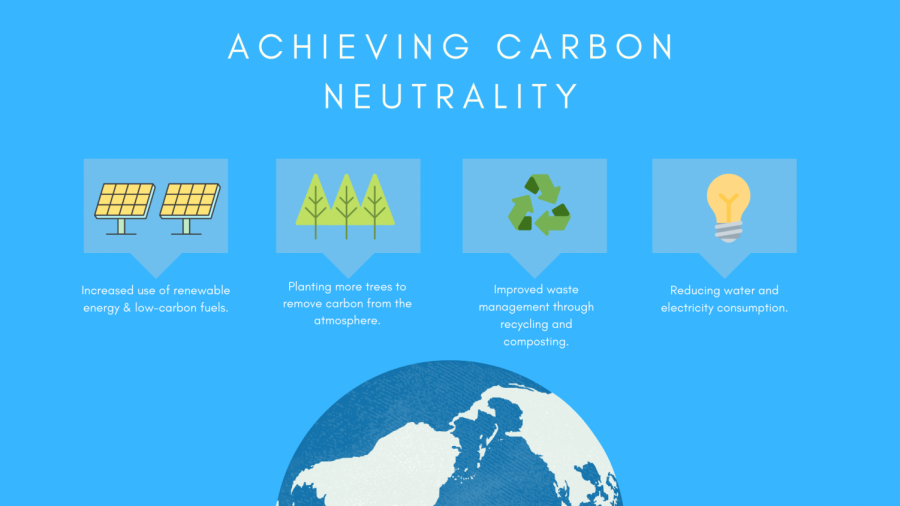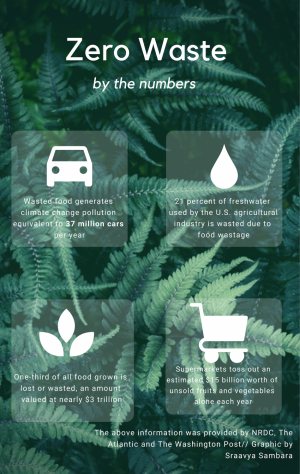Global communities strive toward carbon neutrality in order to combat climate change
February 4, 2020
Hundreds of thousands of protesters of all ages, ethnicities and genders united behind large, colorful banners. A scene in New York, Berlin, London and countless other cities during the climate strike on Sept. 20, 2019. Millions of protesters worldwide united under one common goal: to demand action against climate change.
As more people around the world recognize the threat of global warming, efforts to combat it have grown. These protests are just one example. In particular, the number of initiatives to achieve carbon neutrality has increased, incorporating colleges, companies and even cities and countries.
According to AP Environmental Science teacher Ms. Heida Shaw, carbon neutrality fundamentally is “taking in as much carbon as you’re putting out.” Achieving carbon neutrality can be accomplished in a variety of ways, like planting trees that remove carbon from the atmosphere via photosynthesis or technologies such as carbon capture and sequestration.
On April 25, 2018, President Sylvia Burwell announced that American University had achieved its carbon neutrality goal two years early.
“Our community joined together to accomplish this important goal established in 2010,” President Burwell said. “We wanted to demonstrate leadership and innovation in addressing the serious social, economic and environmental issues associated with global warming. Having a net zero carbon footprint reflects our commitment to acting on our values and leading into the future.”
American University is not the only university to have achieved carbon neutrality. Schools such as Colgate University, the University of San Francisco and Bates College all achieved carbon neutrality in 2019. Earlier, Colby College became carbon neutral in 2013, Middlebury College in 2016 and Bowdoin College in 2018.
In order to accomplish this goal, common tactics like recycling and composting, constructing of green buildings, using water and electricity more efficiently, switching to emissions-free electricity and planting more trees have been used.
Many other colleges have also set goals to achieve carbon neutrality in the future. The University of California is committed to becoming carbon neutral by 2025 through their Carbon Neutrality Initiative. Cornell University has also implemented their Climate Action Plan, which plans to “reduce Cornell’s carbon emissions to net zero by the year 2050 or sooner,” among other goals.
Beyond universities, cities and states have adopted similar initiatives. The Carbon Neutral Cities Alliance (CNCA) is a “collaboration of leading global cities working to cut greenhouse gas emissions by 80-100% by 2050 or sooner.” San Francisco is one of the members of the CNCA, and other prominent members include New York City, Vancouver, Yokohama, London and Amsterdam. In order to support its vision of carbon neutral cities, the CNCA invests in city-led projects, works on planning and implementation standards, and promotes collaboration between members of the alliance and other leading cities.
Extending beyond cities, the U.S. Climate Alliance — a bipartisan coalition of governors — is also fighting for reducing greenhouse gas emissions; their goals align with the Paris Agreement.
“According to independent analysis, the Alliance is on track to continue reducing GHG [greenhouse gas] emissions through 2025, within reach of their GHG emissions reduction target. Considering policies currently in place, their collective GHG emissions are projected to fall by at least 20-27% below 2005 levels by 2025. Compared to last year, Alliance states are now collectively reducing emissions across a larger share of the U.S. economy, making a bigger dent in national emissions,” the Alliance reported on Dec. 9, 2019.
Even entire nations are banding together. Countries in the European Union, excluding Poland, have set a goal for net-zero emissions by 2050 following a European Council meeting in Brussels in December 2019.
“Climate neutrality by 2050 is our common goal, but at the same time, it is correct that for one member state, at this stage, it is not possible to commit to implement this objective,” European Council President Charles Michel said. “It is very important for the European Union [and] the strong message today is we want to become the first climate-neutral continent by 2050.”
Given that carbon dioxide accounted for 82% of greenhouse gas emissions in the U.S. in 2017, such initiatives to reduce carbon emissions and achieve carbon neutrality play an important role in combating climate change.
“I think it’s essential. I think the first thing is to take out as much carbon as we’re putting in so we can stop the change right where we’re at right now,” Shaw said. “We still have the effects, you may have seen the effects in Australia, of the forest fires that we’ve had in California and the Amazon; the world is getting to be very hot and very dry as well. And so that leads to all these different things that can happen because of climate change. I think [carbon neutrality is] essential.”





